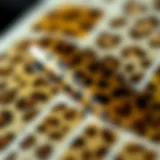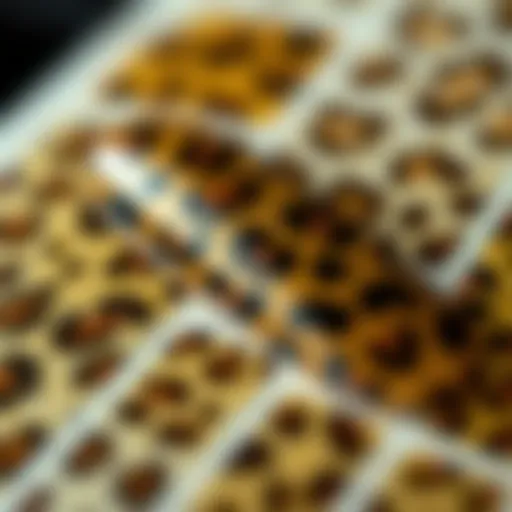Exploring the Cultural Impact of Biker Doo Rags
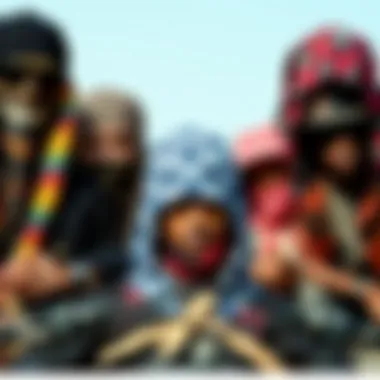

Intro
Biker doo rags, often mistaken as mere accessories, hold a rich tapestry of cultural significance. Emerging from the gritty backdrop of motorcycling culture, they embody a blend of rebellion and identity. These pieces of fabric, once practical tools for riders looking to keep sweat and wind at bay, have evolved into potent symbols of freedom, camaraderie, and style.
The trajectory of biker doo rags stretches far beyond their functional roots. Today, these accessories make statements within fashion circles, appearing on runways and in boutiques, often tailored to suit various aesthetics. Amid this evolution, one must consider the materials, craftsmanship, and even the environmental concerns that go into making them. As we delve into this fascinating subculture, we uncover not just the styles and trends but the deeper meanings tethered to these striking headpieces.
Fashion Trends
Biker doo rags don't just ride the waves of fashion; they often create them. The incorporation of biker doo rags into mainstream fashion reflects changing attitudes toward individual expression and heritage.
Latest Seasonal Trends
Each season breathes new life into how doo rags are styled. For example, as we transitioned from summer to fall, we’ve seen a shift towards deeper, richer colors like burgundy and forest green. This year, patterns have exploded— from floral and paisley to camouflage and geometric designs. These seasonal trends signify more than just what’s hot; they showcase how wearers can adapt classic looks with modern flair.
- Rich colors: Emphasizing earthy tones brings a fresh, grounded feel to outfits.
- Patterns: The popularity of plaid and abstract shapes hints at a playful approach to styling.
- Material blends: Sustainable fabrics are beginning to appear more prominently, combining comfort and conscience.
Iconic Styles Revived
Many styles of biker doo rags have made comebacks in surprising ways. Certain fashion houses have taken inspiration from vintage motorcycle culture, blending nostalgia with contemporary trends. For instance, the classic bandana style, often tied around the head, has resurfaced with a twist—being worn as a neckscarf or even as a belt. This revival illustrates how designs can traverse through time, adapting to new contexts and audiences.
"Fashion is about the freedom to express one's identity, and biker doo rags are at the crossroads of tradition and individualism."
Style Tips
Mastering the art of donning a biker doo rag can elevate any outfit while paying homage to its roots. Here, we sift through practical style tips that can help enthusiasts and newcomers alike embrace these accessories with confidence.
How to Mix and Match
The beauty of biker doo rags lies in their versatility. They can easily transition from a rugged biker look to a chic urban outfit. A few tips to consider:
- Contrast and texture: Pair a smooth, silk doo rag with a distressed leather jacket for a striking contrast.
- Color coordination: Utilize the color wheel—complementary colors can create a more cohesive look.
- Accessories: Layering other accessories like chains or statement earrings can enhance the overall aesthetic.
Dressing for Different Occasions
Whether you're hitting the open road or attending a casual gathering, knowing how to style your doo rag for various settings is vital. For instance:
- Casual outings: Pair a patterned doo rag with a simple white tee and jeans.
- Formal events: Select a luxurious fabric doo rag, such as satin, to pair with a blazer.
- Themed rides or events: Go bold with a bright colored or emblazoned doo rag that reflects the spirit of the occasion.
Preamble to Biker Doo Rags
Biker doo rags serve as more than just a functional accessory; they are a vibrant symbol of identity, lifestyle, and history within the biker community. This unique headwear has found a cherished spot in the hearts of many, encapsulating the spirit of freedom that motorcycling embodies. In this section, we will explore the significance of doo rags, from their practical uses to their deep-rooted cultural implications.
Definition and Purpose
A biker doo rag is essentially a cloth bandana worn primarily by motorcyclists, designed to fulfill multiple roles. Functionally, it helps to keep long hair out of the rider's eyes during a ride, offering a practical solution to a common problem. Additionally, it protects the scalp from the harsh sun and wind while riding. Some enthusiasts might argue that a doo rag is like a knight's helmet, guarding not just the physical but also the persona one wears on the road.
Beyond this functionality, doo rags often represent a statement of individuality. Riders select colors, patterns, and styles that resonate with their personal philosophies or affiliations. For instance, a skull-patterned doo rag may signal a connection to a specific club or sub-culture, while simpler designs might indicate a more laid-back lifestyle. This interplay between practicality and self-expression is what makes the doo rag essential to the motorcycling culture.
Historical Context
The origins of biker doo rags can be traced back to the post-World War II era, a time when motorcycle clubs began to form across the United States. Returning veterans sought camaraderie and a sense of belonging, leading to the establishment of organizations that celebrated the motorcycle lifestyle. At this juncture, the doo rag transformed from a mere workman's item into a symbol of rebellion and freedom.
In many ways, the history of the doo rag is interwoven with the growth of motorcycle clubs such as the Hells Angels and the Outlaws. These clubs adopted the doo rag as part of their unofficial uniform, taking on the connotation of a badge of honor.
This cultural evolution reflects broader societal shifts; as motorcycling grew in popularity during the 1960s and 1970s, so too did the significance of the doo rag as a marker of identity among bikers. It became common to see riders of all backgrounds sporting these head wraps, as the doo rag signified not just a love for motorcycles, but also a commitment to a lifestyle that embraced freedom, community, and non-conformity.
"A doo rag isn't just fabric; it’s a banner of rebellion and unity among those who live on two wheels."
In summary, the biker doo rag holds a place of considerable importance in motorcycling culture and tradition. By understanding its definition and historical context, we pave the way for a deeper exploration of its evolution, styles, and overall impact on the identities of the individuals who proudly wear them.
Origins of the Biker Culture
The roots of biker culture stretch deep into the annals of American history, presenting a vibrant tapestry woven from rebellion, freedom, and community. Understanding this foundation is crucial to appreciating the cultural significance of items such as biker doo rags, as these accessories are not mere fashion statements but symbols infused with meaning. To grasp their importance, we must first delve into the key elements that spurred the rise of motorcycling as a lifestyle.
The Rise of Motorcycle Clubs
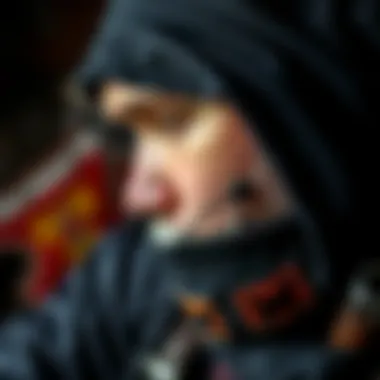

As World War II came to a close, many veterans found themselves craving a sense of belonging in a society that felt foreign after their service. Enter motorcycle clubs, which emerged in the late 1940s and early 1950s as havens for those seeking camaraderie. Clubs like the Hells Angels and the Outlaws were formed—allowing them to bond over shared experiences and a love of riding. These organizations became more than just clubs; they carved out distinct identities for their members, resulting in a lifestyle characterized by brotherhood and a code of ethics that espoused loyalty and rebellion.
The introduction of the Harley-Davidson motorcycle played a pivotal role in this emergence, too. The brand's rugged image fit perfectly with the rough-and-tumble ethos of the time. Riding together on roaring machines became a way to express freedom—both from societal norms and personal strife. Wearing doo rags became a part of this identity, used initially to keep sweat and dirt at bay, but evolving into a symbol of unity within the biker community. It showcased allegiance to the club, while also reflecting a distinctive yet accessible style. This rise of motorcycle clubs set the stage for the doo rag to become a staple of biker culture—encoding a blend of practicality and identity.
Fashion as a Statement
Biker doo rags are not simply utilitarian headwear; they have evolved into powerful fashion statements. The cultural milieu surrounding bikers is rich with visual symbols that convey much more than aesthetics. Wearing a doo rag can signify several things: an affiliation with motorcycle culture, a nod to countercultural rebellion, or even just a flair for distinctive style.
Each design choice—from colors to patterns—often bears significance. For instance, the color black is prevalent among bikers, representing strength and resilience. Meanwhile, a checkerboard pattern might draw associations with speed and racing culture. As bikers became more visible in mainstream consciousness, so too did the doo rag's appeal, transcending its functional origins to become a fashion accessory for anyone marrying comfort with edgy vibes.
The doo rag's versatility means it can be styled in various ways, allowing wearers to express their individuality even within the bounds of group identity. Thus, doo rags transitioned from practical uses to symbols of personal expression. The intertwining of personal and communal identity through fashion helps solidify the importance of these accessories within the biker community, making them emblematic of a lifestyle steeped in history and culture.
"A man's character is not judged after he celebrates victory, but by what he does when his back is against the wall." - Bobby Fischer
In summary, the origins of biker culture and its relationship with doo rags offer an insightful lens through which to understand not just a clothing item, but a vibrant, living community marked by an enduring sense of identity. As we continue to explore the cultural significance of these accessories, we find ourselves confronted with a rich history that informs their modern interpretations.
Materials and Craftsmanship
The materials and craftsmanship behind biker doo rags serve not only functional purposes but also add layers of identity and meaning to this iconic accessory. Every fiber woven into these rags tells a story, embodying the spirit of freedom and rebellion that bikers hold dear. Choosing the right fabric and ensuring quality workmanship are fundamental in aligning a doo rag’s purpose with the wearer’s lifestyle.
Understanding the materials used in these accessories allows us to appreciate the practical benefits they offer, from breathability to durability. Moreover, craftsmanship reflects the tradition and care that goes into creating a doo rag, distinguishing between mass-produced and handmade options.
Common Fabrics Used
Biker doo rags are primarily made from a variety of fabrics, each chosen for its specific attributes. Here’s a look at some of the commonly used materials:
- Cotton: This classic choice is lightweight and breathable, making it ideal for hot weather. Its softness ensures comfort during long rides.
- Polyester: Known for its durability and moisture-wicking properties, polyester is favored for its ability to keep the rider dry while also being easy to care for.
- Silk: Although less common, silk is sometimes used for its luxurious feel and natural sheen, giving a more refined look to the wearer.
- Lycra/Spandex: These materials are often blended with cotton or polyester to allow for stretch, ensuring a snug fit that helps the doo rag stay in place.
Each fabric adds a unique flair and functionality to the doo rag. The choice of fabric can be influenced by climate, personal comfort, and even aesthetic preference.
Handmade vs. Mass-Produced
When it comes to the crafting of biker doo rags, a clear distinction exists between handmade and mass-produced options. Each has its merits, appealing to different audiences within the biker community.
- Handmade Doo Rags: These are often made with careful attention to detail, ensuring quality stitching and unique designs. Artists and craftsmen might incorporate personalized elements, reflecting the individuality of the rider. This craftsmanship can lead to a higher price point but also carries with it a sense of exclusivity.
- Mass-Produced Doo Rags: Produced in factories, these items are more accessible and come at a lower cost. While they may lack the personal touch, mass production allows for wider availability, catering to a larger audience. However, the quality may vary significantly, and some fashion-forward bikers may shy away from them due to the risk of losing unique identity.
"The right doo rag is not just about style; it’s about embracing the ride, letting the wind know your journey."
For further reading on fabric types, you might find Britannica helpful. Additionally, discussions on the topic can be explored further at Reddit.
Style Variations of Biker Doo Rags
In the realm of biker culture, doo rags are not just practical accessories; they embody a unique style that reflects the personality and identity of the wearer. The variations in style that these doo rags showcase are significant, representing not only fashion but also the evolution of the biker scene itself. Understanding these variations can provide insightful perspectives for stylists, designers, and marketers, making it crucial to delve into this subject.
Classic Designs
Classic designs of biker doo rags often take inspiration from early motorcycling aesthetics and biker subcultures that emerged during the mid-20th century. These traditional styles are characterized by their bold colors, striking patterns, and distinctive fabric choices. Commonly seen in black or deep, vibrant hues, classic designs typically feature:
- Bandana Patterns: Paisley motifs are quintessential, often associated with rebellion and a rugged lifestyle.
- Solid Colors: Black, blue, or red hues predominately represent loyalty, pride, or simply a no-nonsense attitude.
- Custom Art: Many bikers will also opt for doo rags that feature custom artwork. These can range from tribal designs to detailed illustrations that tell a personal story.
Such designs have become a staple within the community, worn not only for their style but also as a mark of belonging and camaraderie among bikers. The way a doo rag is styled can say a lot about its wearer's personal experiences and their connection to the biking world.
Modern Interpretations
As time marches on, so does the evolution of biker doo rags. Modern interpretations are where innovation meets tradition. Designers are increasingly incorporating fresh ideas into these accessories while still paying homage to their roots. Contemporary styles often trend toward:
- Unique Fabrics: New materials such as moisture-wicking blends or eco-friendly fabrics allow for comfort and sustainability. Look for options that blend style with functionality.
- Fashion Collaborations: Many fashion designers and brands now collaborate with bikers to create doo rags that align with mainstream fashion trends, resulting in fashionable accessories suitable for everyday wear.
- Interactivity: Some modern doo rags even incorporate tech aspects, like hidden pockets for small gadgets or QR codes that link to social media profiles, showcasing the biker's digital presence.
These variations not only cater to the changing tastes in fashion but also encourage a growth in the biker community’s presence in broader pop culture.
"Biker doo rags are more than just gear; they're a form of self-expression that withstands the test of changing times and styles."
The evolution of style variations in biker doo rags signifies a fusion of personal identity, cultural heritage, and contemporary fashion. A deep understanding of these styles can lead to more informed decisions in design and marketing, bridging the gap between tradition and new trends. Whether it's a classic paisley pattern or a modern, tech-friendly fabric, these doo rags continue to reflect the ever-evolving lifestyle of riders.
Practical Benefits of Biker Doo Rags
Biker doo rags aren't just fashion statements; they serve a multitude of practical functions that make them essential for many riders. Understanding these benefits is crucial for anyone considering adopting this accessory, especially within the context of a culture that values both style and functionality. Here, we will delve into how biker doo rags contribute to sun protection and hair management, both of which are significant for riders.
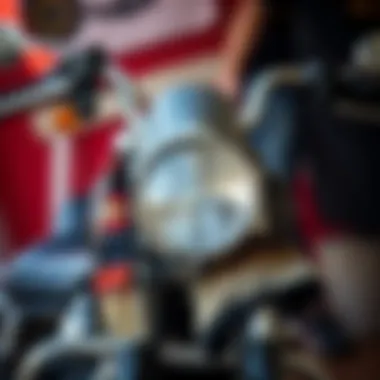

Sun Protection
Bikers often spend hours exposed to the sun while cruising along the open road. The lightweight fabric of doo rags provides a practical layer of protection against harmful UV rays.
- Skin Safety: Wearing a doo rag can help shield the skin on the scalp and neck from sunburn. This is especially useful for those who maintain a close-cropped hairstyle or have thinning hair. A simple accessory can significantly reduce the risk of sun damage, making it a thoughtful addition to a biker's gear.
- Temperature Regulation: The right fabric can also help in regulating body temperature. A doo rag can absorb sweat, providing a cooling effect for the rider. This is critical during long rides on hot days, allowing for a more comfortable experience.
- Fashion Meets Function: Many riders also appreciate that these accessories come in various colors and patterns. This allows bikers to express their personal style while still gaining the practical benefits of sun protection. In essence, what started as a utilitarian piece has evolved into a fashion choice that respects the environment riders are exposed to.
"A biker's doo rag not only showcases individuality but serves a functional role, often being seen as armor against the sun."
Hair Management
Another crucial aspect of biker doo rags is their role in hair management. For many riders, maintaining their hairstyle during long rides can be a challenge. Here’s how doo rags come into play:
- Wind Control: The wind can wreak havoc on a rider's hair. A doo rag keeps hair in place, preventing it from flying around and creating distractions while on the road. This is essential not just for aesthetics but also for safety; a well-managed hairstyle means a rider can focus on the road ahead.
- Protection from Debris: When riding, various elements such as dust, insects, and debris can easily get caught in the hair. A biker doo rag acts as a barrier, keeping hair healthy and clean.
- Stylistic Choices: For those with longer hair, doo rags can provide an additional styling option, as they can be worn in different ways. They can be tied into a fashionable bandana style or worn as a full cap, fulfilling both functional and shape-related needs.
Cultural Impact and Symbolism
Biker doo rags hold a significant place within both the motorcycle community and the broader cultural landscape. Far beyond mere fashion accessories, they embody a rich tapestry of identity, expression, and social dynamics. Understanding their cultural impact requires a deep dive into how they resonate within different communities and the meanings they convey about individuality and group affiliation.
Identity Expression
For many bikers, the doo rag is more than a utilitarian piece; it’s a canvas for personal expression. These headscarves often display intricate designs, logos, or even catchphrases that resonate with the rider's personality or affiliations.
- Personalization: Choices in color, pattern, and texture often reflect personal style or even rebellion against societal norms. Some may opt for classic black, while others could choose bold colors or patterns that make a statement.
- Affiliation Markers: Many doo rags exhibit symbols from motorcycle clubs, acting as a badge of honor and allegiance. This fosters a sense of belonging, as members showcase their loyalty and connect with others who share their passions.
Bikers can often be seen wearing these items not just on the road but in everyday life as well. This speaks volumes about how integrated the culture has become, blending with other aspects of identity and fashion.
Connection to Rebellion
The sight of a rider with a doo rag conjures associations with freedom, independence, and a rebellious spirit. This accessory has become synonymous with defiance against societal expectations. Riders often utilize the doo rag as a statement against conformity, taking pride in their unique lifestyle choices.
- Counterculture Symbol: Initially, biker culture emerged as a rebellious response to post-war societal norms. The doo rag embodies this very ethos, representing freedom of choice and the rejection of conventional values.
- Media Influence: Iconic portrayals in films and television have cemented the association between bikers and rebellion. From classics like Easy Rider to modern series depicting motorcycle culture, doo rags often feature prominently as symbols of individualism and challenge against authority.
"The doo rag is a symbol of the rugged, untamed spirit typical of bikers, reflecting not just personal style but a lifestyle choice that stands in stark contrast to the mainstream."
The cultural impact of biker doo rags draws deep roots into how individuality, affiliation, and rebellion intertwine, creating an intricate dialogue that extends beyond just a piece of fabric. As these accessories continue to evolve, they forge new paths in fashion and identity, remaining a relevant touchstone within the cultural landscape.
Biker Doo Rags in Popular Media
Biker doo rags have carved out a distinct niche within popular media, transcending mere fashion to embody cultural narratives that resonate with audiences worldwide. As integral pieces of biker attire, these accessories are often featured across various media channels, serving not only as style statements but also as symbols of identity, rebellion, and freedom. From films that portray the raw energy of the open road to songs that extol the lifestyle of bikers, doo rags appear as vital elements that enrich those narratives. Understanding this impact is essential for appreciating their role in both biker culture and their influence on broader societal perceptions.
Films and Television
In film and television, biker doo rags often symbolize the gritty, rebellious spirit that defines motorcycle culture. Iconic movies like Easy Rider and The Wild One effectively utilized the doo rag as a visual shorthand for the freedom and defiance characterizing the biker lifestyle. These films not only spotlight the accessories but also create archetypes that audiences can connect with.
Moreover, television series such as Sons of Anarchy have cemented the doo rag's association with brotherhood and loyalty. The characters’ frequent use of these rags showcases their identity as outlaws, further embedding this symbolism in the popular imagination. As viewers engage with these narratives, there is often a subconscious assimilation of doo rags' cultural significance, intertwining them with themes of individualism against societal norms.
"The biker doo rag is not just an accessory; it’s a badge that carries the weight of history, rebellion, and community."
Music and Lifestyle
Music plays a pivotal role in amplifying the cultural significance of biker doo rags, with genres like rock and country often highlighting the freedom of the ride while incorporating doo rags as essential elements in their aesthetic. Bands such as Lynyrd Skynyrd and Southern rock artists frequently reference the biker experience in their lyrics, celebrating the journey and lifestyle that many listeners can relate to.
Furthermore, the visual imagery associated with concerts and album covers often depicts musicians donning doo rags, reinforcing their connection to rebellion and the nomadic spirit of biking. In the lifestyle realm, events like bike rallies and music festivals feature bikers sporting doo rags as important identifiers, merging music with motorcycle culture in a way that reflects community and shared values.
The blending of biker symbols into music and lifestyle creates a culturally rich tapestry that extends beyond mere fashion statements, urging enthusiasts and newcomers alike to recognize their significance.
Through the lens of popular media, biker doo rags become much more than fabric; they become conduits of identity expression and community cohesion.
Sustainability in Production
In today's world, the conversation around sustainability has gained immense traction, reshaping industries from fashion to technology. For biker doo rags, this subject is particularly critical as it influences production methods, material sourcing, and the overall impact on our planet. Understanding sustainability is not just about adhering to trends; it's about recognizing the responsibility manufacturers and consumers share in reducing environmental footprints.
Environmental Considerations
The environmental impact of producing biker doo rags is multifaceted. Typically made from fabrics like cotton, polyester, or blends, the production process can be resource-intensive. Cotton, for instance, requires considerable amounts of water and pesticides, raising concerns regarding resource management and ecological health. In contrast, synthetic fibers such as polyester, derived from petroleum, contribute to pollution levels during both production and disposal.
To mitigate these issues, brands are beginning to explore alternatives that significantly lessen their ecological footprints. Organic cotton and recycled materials are becoming more popular in the industry. By using organic methods, manufacturers can avoid harmful pesticides, benefitting both biodiversity and the soil's quality. Furthermore, brands like Bandanna and Doo Rags are pushing boundaries by creating their products from recycled plastics, steering away from virgin materials and reducing landfill waste.
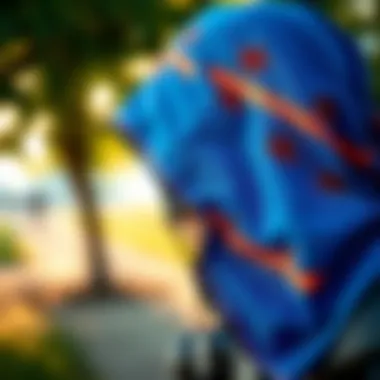

"In a world that's increasingly aware of its ecological challenges, the potential for conscientious production is not just a plan—it's a necessary evolution."
Ethical Sourcing of Materials
Ethical sourcing plays a crucial role in fashion, including in the manufacture of biker doo rags. Beyond ensuring fair labor practices, it addresses the broader implications of sourcing materials. Many businesses are recognizing that the transparency of their supply chains can directly influence consumer choices. Customers today do not simply care about aesthetics; they want to know the story behind their purchases.
Materials sourced under ethical guidelines often come from suppliers that prioritize fair wages, safe working conditions, and community support. Brands focusing on ethical practices, like Doo Rag Co. or Ragged Edge, often proudly share their sourcing stories and the journeys of their products on social media platforms, aiming to foster a connection with consumers.
When selecting materials, companies must also consider the lifecycle of their products—from creation to disposal. Biodegradable fabrics or those that can be easily recycled contribute to a circular economy, thereby reducing waste. Such choices reflect a brand's commitment to sustainability and a conscious effort to reflect the values of its customer base.
Through both environmental considerations and ethical sourcing practices, the future of biker doo rags looks promising, aligning fashion with sustainability. Engaging with these ideas allows for a richer, deeper understanding of the cultural tapestry that biker doo rags represent, creating connections that go far beyond mere appearances.
Trends in Biker Fashion
The realm of biker fashion is ever-evolving, with biker doo rags emerging as a key element in a landscape characterized by unique style expressions. These accessories have transitioned from merely functional items to symbols of identity and rebellion, blending seamlessly into broader fashion trends. Understanding this evolution is crucial for stylists, designers, and marketers who wish to grasp the nuances of biker culture and its impact on the fashion industry.
Integration with Mainstream Fashion
In recent years, biker doo rags have been gaining traction within mainstream fashion. Fashion houses and designers have begun to draw inspiration from the gritty, rugged aesthetic of motorcycle culture. This is evident in various runways and collections that feature biker elements, including leather, studs, and, of course, doo rags. The once niche accessory now appears in diverse streetwear lines, connecting the core of biker style with high-fashion sensibilities.
The integration of doo rags into broader fashion may suggest a redefinition of what it means to be fashionable today. No longer relegated to the motorcycle enthusiast, these items cater to a range of consumers. For instance, streetwear brands have adopted them as a style statement that goes beyond the biker community, signifying a blend of rebellion and coolness. This crossover indicates a powerful shift, revealing how once-specific subcultures can influence and infiltrate mainstream fashion.
- Key elements of this integration include:
- Collaboration: Partnerships between motorcycle brands and fashion designers help elevate doo rags in new collections.
- Celebrity Endorsements: Influencers and musicians are frequently spotted draped in stylish doo rags, furthering their appeal.
- Social Media: Platforms like Pinterest and Instagram allow for rapid sharing of biker-inspired looks, prompting wider acceptance.
This convergence is not without challenges. As these accessories become more popular, there are questions about cultural appropriation and the authenticity of their use outside biker communities. Understanding these nuances aids in navigating the often complex landscape of fashion integration.
Influence on Street Style
Biker doo rags have left a striking imprint on street style as well, marking their territory as a fashion staple across urban landscapes. Street style often reflects a sense of individuality and a connection to one’s environment–values at the heart of biker culture. The adoption of doo rags by diverse populations signifies not just a fashion choice, but also a connection to the broader narrative of rebellion and freedom.
The common sight of doo rags at music festivals, urban art events, and casual city strolls speaks volumes about their versatility. Mix and match styles create a sense of personal identity, allowing wearers to express their individuality. This has spurred a rise in DIY approaches, with enthusiasts customizing their doo rags to reflect personal taste.
"Fashion is not just clothes; it’s a reflection of the society we live in and the stories we tell."
To understand their influence on street style, consider the following:
- Accessibility: Biker doo rags are affordable and easy to wear, appealing to younger demographics seeking unique expressions.
- Cultural Hybridization: The blend of biker aesthetics with other influences, such as punk and hip-hop, creates a rich tapestry of street style.
- Sustainable Practices: With a growing emphasis on sustainable fashion, many consumers opt for doo rags made from recycled materials, attracting eco-conscious buyers.
In essence, biker doo rags have transcended their practical origins, evolving into markers of cultural identity. They shape and reflect trends in fashion and street style, crafting pathways for discussions around authenticity and appropriation. As these styles continue to evolve, it will be fascinating to observe how they influence future fashion narratives and practices.
The Future of Biker Doo Rags
The future of biker doo rags is an intriguing topic that encapsulates the ongoing evolution of both biker culture and fashion trends. As motorcycle riders continue to adopt personal styles that reflect their identity and practical needs, doo rags stand at a crossroads, blending the past with a future that has yet to be fully realized. Key elements will play a role in shaping the trajectory of these accessories in the years to come.
On one hand, practical considerations concerning comfort, functionality, and design choices remain paramount for riders. On the other hand, the influence of modern fashion trends, sustainability concerns, and shifting cultural values present unique challenges and opportunities. Biker doo rags are no longer just simple pieces of fabric; they serve as a canvas for artistic expression and identity affirmation within the biker community.
Innovation in Design
The innovation in design for biker doo rags promises a future where aesthetic appeal aligns seamlessly with functionality. Contemporary designers are finding ingenious ways to integrate modern fabrics and advanced technology into these age-old accessories.
One possible direction is incorporating moisture-wicking materials that offer better sweat management, especially for long rides under the sun. This enhances comfort, as traditional cotton fabrics often fall short in performance. Additionally, designs with reflective elements could enhance safety during night rides, combining utility with style.
A shift towards customizable doo rags that allow riders to express their unique personalities is also gaining traction. For instance, some brands have already ventured into allowing customers to choose patterns, colors, and even incorporate personal symbols or names. This level of personalization deepens the connection between the rider and the accessory, transforming it from mere functionality to a meaningful emblem of one’s individual journey.
Key Design Innovations to Watch For:
- Technical Fabrics: Understanding material science might reveal options like breathable mesh or UV-protective fabrics.
- Smart Features: Imagine doo rags embedded with sensors that can alert wearers of incoming weather changes or allow for integrated communication if riding in a group.
- Artisanal Collaborations: Partnerships with local artists can offer limited-edition collections, further bridging the gap between high fashion and biker culture.
Potential Risks to Cultural Identity
As biker doo rags evolve, there looms the risk of cultural dilution if traditional elements are overshadowed by mainstream fashion trends. Once purely a symbol of biker culture, there are concerns that doo rags may become commodified, losing their original meaning in favor of mass-market appeal.
The influx of fashionable doo rags into retail chains can compromise the authenticity that many within the biking community hold dear. When a doo rag is worn more for fashion than as a depiction of one's affiliation with biker subculture, it can create a dissonance in identity. Riders often wear these accessories not just for practical reasons, but as a declaration of their belonging.
This shift could lead to a fragmentation of the community, where traditionalists feel that the burgeoning fashion trends overshadow the rich history and values embodied by the doo rag.
"As biker culture becomes intertwined with the broader fashion industry, the essence of what it means to ride and belong to a community faces potential upheaval."
To Mitigate These Risks, Consider:
- Emphasizing Heritage: Brands should promote the history and significance of doo rags in their marketing.
- Community Engagement: Engaging with biker groups and hosting events can help preserve the cultural aspects of this accessory.
- Ethical Production: Prioritizing local craftsmanship and sustainable practices can help maintain respect for the roots of biker culture.
With a thoughtful approach to design and community engagement, the future can hold great promise for biker doo rags, ensuring they remain both practical tools for riders and cherished symbols of identity.


